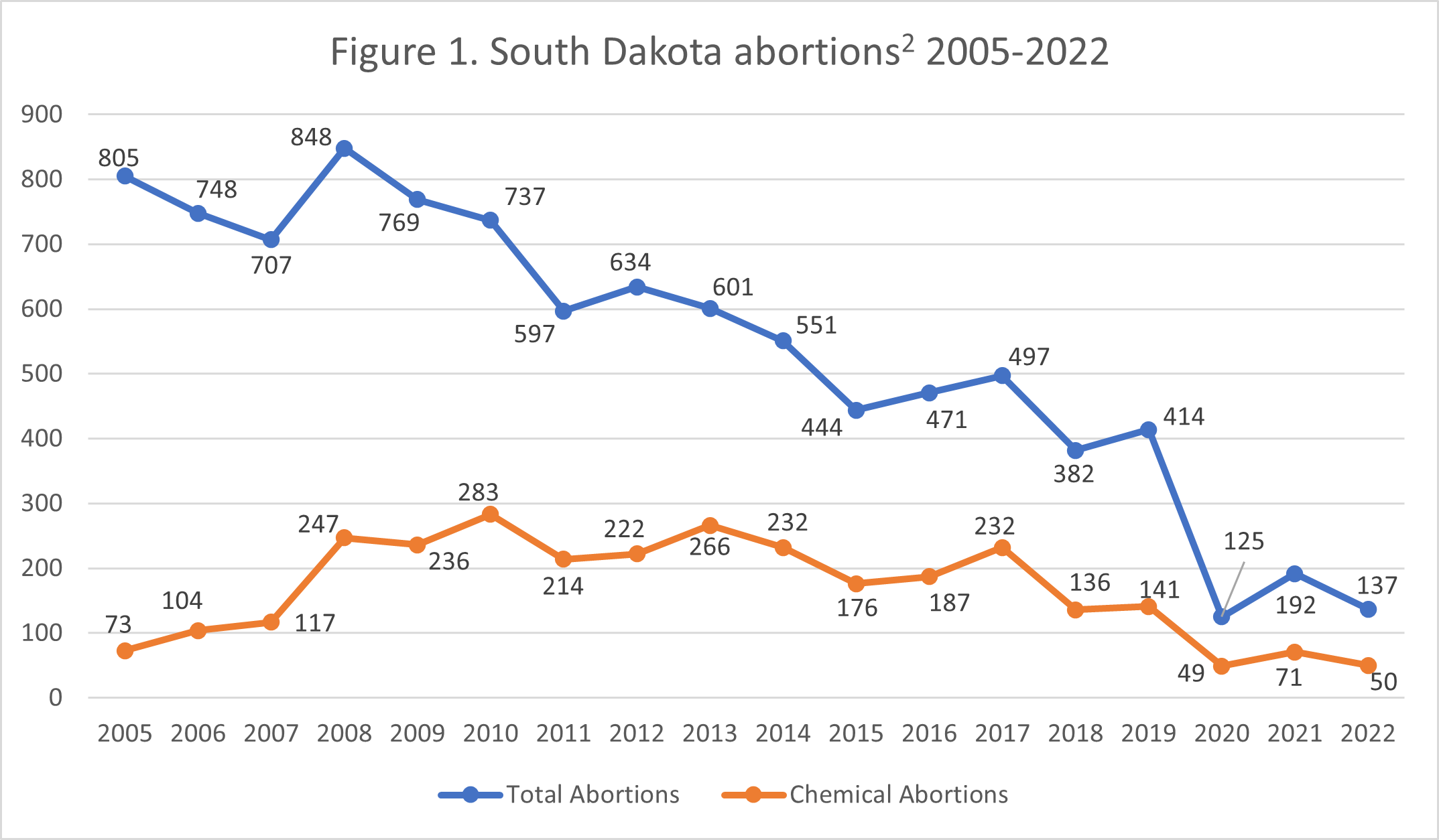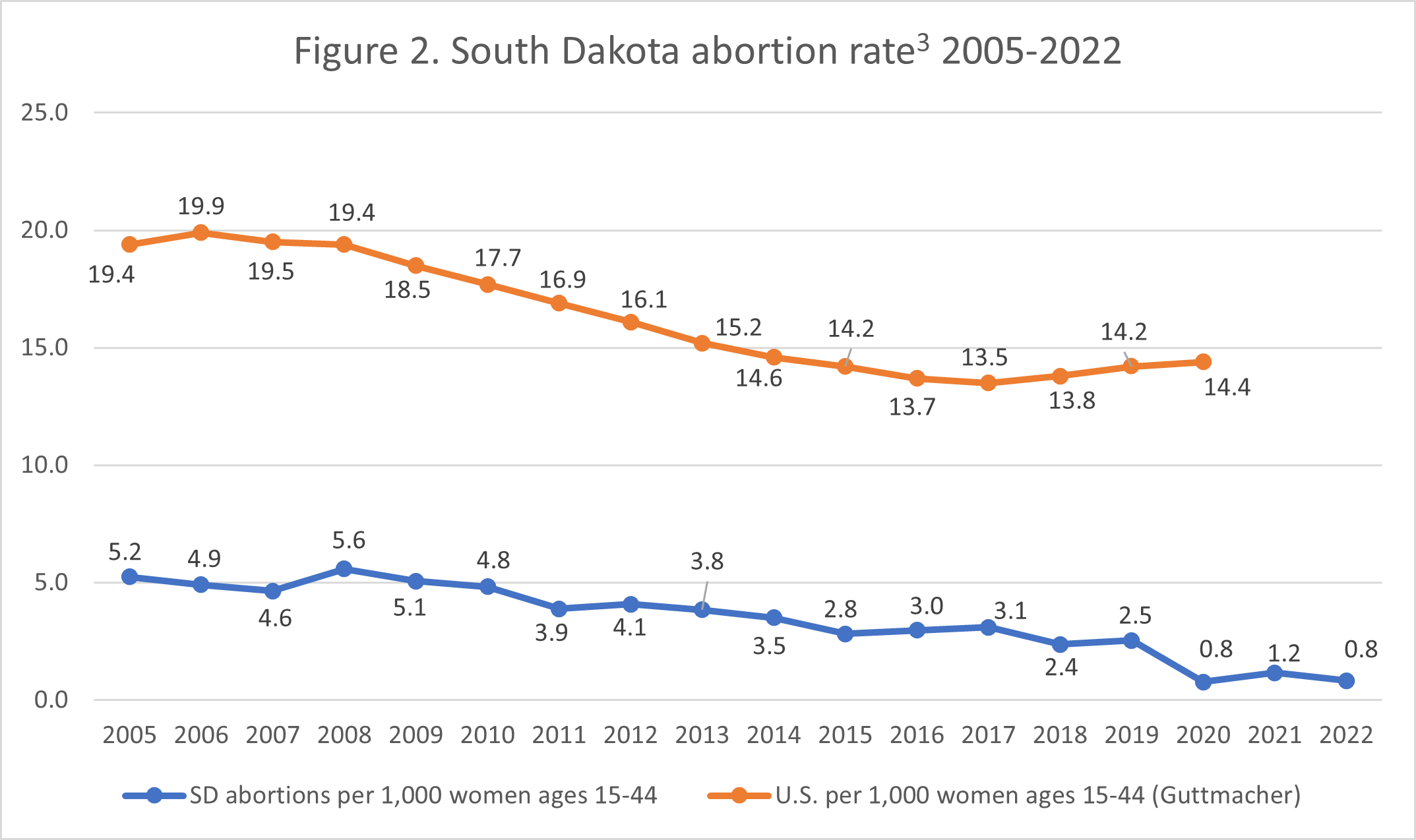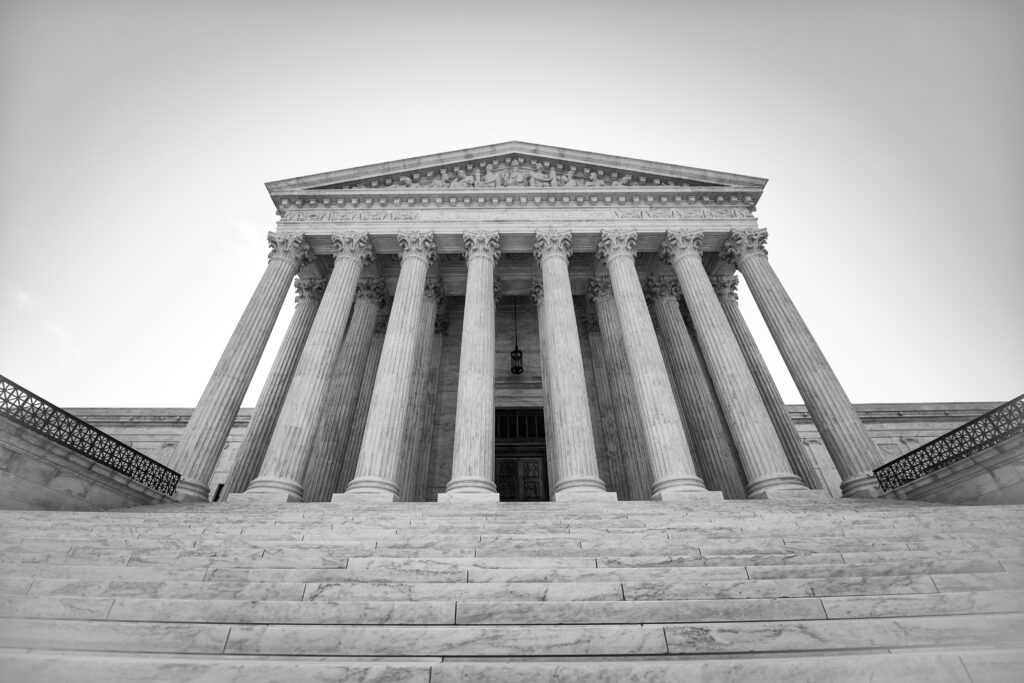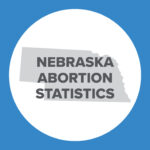Abortion Reporting: South Dakota (2022)
South Dakota’s 2022 abortion report was published by the South Dakota Department of Health in June 2023. The report shows that total abortions (including chemical abortions) decreased from 2021.
Statistics and Changes in South Dakota Abortions, 2021-2022

The report does not include information on Planned Parenthood’s South Dakota abortion market share.
Abortion Totals and Trends
There were 137 abortions reported in South Dakota in 2022, a decrease of 29 percent from 2021 and a decrease of 83 percent from 2005 to 2022 (Fig. 1). Chemical abortions, which constituted 36 percent of all abortions in the state, decreased by 30 percent. The Charlotte Lozier Institute (CLI) estimates that South Dakota’s abortion rate was 0.8 abortions per 1,000 women of childbearing age, a decrease of 29 percent since 2021. As of August 2023, 16 states have released 2022 abortion statistics, with five showing that abortion decreased from 2021.
State Report Summary
In 2022, 90 percent of South Dakota abortions were performed on state residents. Six percent were performed on women from Minnesota, and two percent (three abortions) each were obtained by women from North Dakota and from other, unspecified states. Thirty-seven percent of the abortions were performed on women ages 20 to 24, while 23 percent were performed on women ages 25 to 29. An additional 30 percent were performed on women in their thirties, while one percent were obtained by women in their forties or older. Eleven abortions were performed on girls under the age of 20 (eight percent), including five abortions on girls under 18. Parental notification was provided in four of the five instances where a minor under age 18 was seeking to obtain an abortion. In one case, the minor’s parent or guardian was not notified, but a judge authorized the physician to perform the induced abortion.
Sixty-one percent of the abortions reported in South Dakota (84 abortions) were performed on non-Hispanic white women. Eleven percent (15 abortions) were on non-Hispanic black women, and 10 percent (14 abortions) were on non-Hispanic American Indian women. Four abortions (three percent) were performed on non-Hispanic women of multiple races. Six percent (eight abortions) were on non-Hispanic Asian women. Eleven abortions (eight percent) were on Hispanic women. Race was not reported for one abortion.
Forty-seven percent of South Dakota abortions were performed on women with a high school education or less. Thirty percent were on women who had completed some college, and 22 percent were on women with a college degree or another type of certificate. Eighty-two percent of the abortions (113 abortions) were performed on unmarried women, and 18 percent (24 abortions) were on married women.
Nearly three-quarters of the abortions, 72 percent, were obtained by women who reported no prior abortions. Nineteen percent were on women with one previous abortion, and nine percent on women with more than one prior abortion. Thirty percent of South Dakota abortions were on women with two or more living children, 27 percent on women with one living child, and 43 percent on women with no living children. Twelve percent of the abortions were performed on women who previously had a miscarriage.
Sixty-one percent of the abortions reported in South Dakota in 2022 were suction abortions, and two percent were performed using dilation and evacuation procedures. Thirty-six percent of the abortions were chemical. Twenty percent of the abortions occurred at six weeks of gestation or earlier, and 28 percent were reported between seven and eight weeks. Twenty-seven percent of South Dakota abortions were performed between nine and 10 weeks of gestation, 21 percent between 11 and 12 weeks, and four percent at 13 weeks of gestation or later. There was one, unspecified abortion-related complication reported in 2022.1
Eighty-two percent of the abortions were self-paid. Seventeen percent (23 abortions) were covered by private insurance, and one percent (two abortions) were covered by a public health plan, which South Dakota defines as “any plan established or maintained by a state, county, or other political subdivision of a state that provides health insurance coverage to enrolled individuals.” The majority of abortions (81 percent) cost between $600 and $699. Fifteen percent cost $700 or more and four percent cost less than $600.
Thirty-six percent of women undergoing abortions in South Dakota did not receive anesthesia. A local anesthetic was used for 61 percent of the abortions, and a general anesthetic was used for two percent. Fifty-six percent of the abortions were performed by OB-GYNs, and 44 percent were performed by doctors specializing in family medicine.
The baby’s weight was not reported for 68 percent of the abortions. Of those that were reported, six percent of the unborn babies killed by abortion weighed less than 50 grams, 12 percent weighed between 50 and 74 grams, and nine percent weighed between 75 and 99 grams. Four percent weighed between 100 and 124 grams, while one unborn child killed by abortion weighed 125 grams or more. Three of the unborn babies had abnormalities, though the report did not indicate the types of abnormalities the babies had. It was unknown whether the remaining 134 babies had abnormalities.
Sixty-three percent of the unborn babies’ bodies were incinerated, and 37 percent were disposed of as medical waste or discarded via unknown means.
In South Dakota, women’s reasons for choosing abortion are recorded, and they can give more than one reason. Consequently, percentages sum to greater than 100 percent. Sixty-five percent of the abortions were performed because the woman did not desire to have the child, and 49 percent were performed because the woman could not afford the child. Twenty-three percent were performed for the woman’s emotional health, three percent (four abortions) were performed due to the risk of harm to a major bodily function, and four abortions (less than one percent) were performed because of rape or incest. Twelve percent of the abortions were performed for some other reason.
The South Dakota Department of Health received 157 informed consent forms in 2022. Of the 157 women, 137 went on to obtain abortions, and 20 did not.
The opportunity to view the ultrasound was offered to 155 women, of whom 85 accepted while 70 did not. The report does not indicate how many of these women went on to have an abortion. Similarly, 154 forms indicated that the woman was offered the opportunity to listen to her baby’s heartbeat; 49 accepted the opportunity.
Legislative Changes
As CLI mentioned in a previous article, South Dakota’s trigger law, passed in 2005, went into effect when Roe v. Wade was overturned on June 24, 2022. This law protects unborn babies from abortion throughout pregnancy with an exception for cases in which the life of the mother is at risk. The state’s long and steady efforts to protect unborn children from abortion have been impactful. Monthly data included in the state’s 2022 annual report shows that monthly abortion totals dropped to zero for the remainder of the year following the enforcement of the state’s trigger law at the end of June. The July through December 2022 totals are in stark contrast to totals during that same period in 2021 and in years prior.
Figure 1- Monthly Abortion Occurrences in South Dakota, 2018-2022
| 2022 Monthly Ab. Totals | 2021 Monthly Ab. Totals | 2020 Monthly Ab. Totals2 | 2019 Monthly Ab. Totals | 2018 Monthly Ab. Totals | |
| January | 6 | 9 | 25 | 25 | 20 |
| February | 15 | 14 | 39 | 26 | 39 |
| March | 26 | 12 | 27 | 37 | 35 |
| April | 25 | 13 | 0 | 32 | 18 |
| May | 37 | 19 | 0 | 35 | 42 |
| June | 28 | 17 | 0 | 49 | 35 |
| July | 0 | 19 | 1 | 36 | 31 |
| August | 0 | 17 | 1 | 62 | 39 |
| September | 0 | 20 | 1 | 44 | 32 |
| October | 0 | 21 | 11 | 30 | 39 |
| November | 0 | 16 | 11 | 11 | 32 |
| December | 0 | 15 | 9 | 27 | 20 |
| Total | 137 | 192 | 125 | 414 | 382 |
In addition to the state’s trigger law going into effect in June 2022, the state was also able to protect women and unborn children earlier in 2022. In March 2022, Governor Kristi Noem signed HB1318. This bill prevents chemical abortions from being administered via telemedicine or through mail. The law also increases the penalty for the unlicensed practice of medicine involving chemical abortion. This law could partially explain why chemical abortion totals decreased in the state from 2021 to 2022. Furthermore, the state’s persistent commitment to protecting women from dangerous chemical abortion drugs (especially mail order abortions) could be part of the reason why the percent of chemical abortions making up the total number of abortions is amongst the lowest in the nation.
State Ranking
In 2016, CLI analyzed abortion reporting across the 50 states, New York City, and the District of Columbia. South Dakota’s reporting was tied for 7th best. South Dakota could further improve its reporting by requiring all healthcare professionals and facilities, including emergency rooms, to report abortion complications they encounter. South Dakota could also report the types of abnormalities that unborn babies had.


- Statistics on abortion complications reported here represent a minimal number of deaths and complications, as this data is collected in a non-systematic and non-verifiable way. As such, this data cannot be used to calculate either an accurate abortion mortality rate or an accurate abortion complication rate for the state.
- The drop in abortions in South Dakota in April-September 2020 was due to the state having a travel ban in place during the COVID-19 pandemic, which prevented out-of-state doctors from flying into the state to perform abortions.
- National rates were calculated by Guttmacher Institute. South Dakota rates were calculated by CLI using the following formula: (total number of abortions performed in South Dakota ÷ number of resident women ages 15-44) x 1,000. Rates may differ slightly from previous CLI articles due to revised population estimates. Population estimates were obtained from the CDC WONDER database. Estimates for 2005-2009 are intercensal estimates of the July 1 resident population. Estimates for 2010-2019 are Vintage 2020 postcensal estimates of the July 1 resident population. Estimates for 2020-2022 are Vintage 2021 postcensal estimates of the July 1 resident population as the CDC has not yet released 2022 population estimates. Estimates were produced by the U.S. Census Bureau and the National Center for Health Statistics.
Click here to view reporting from:2023202120202019201820172016























